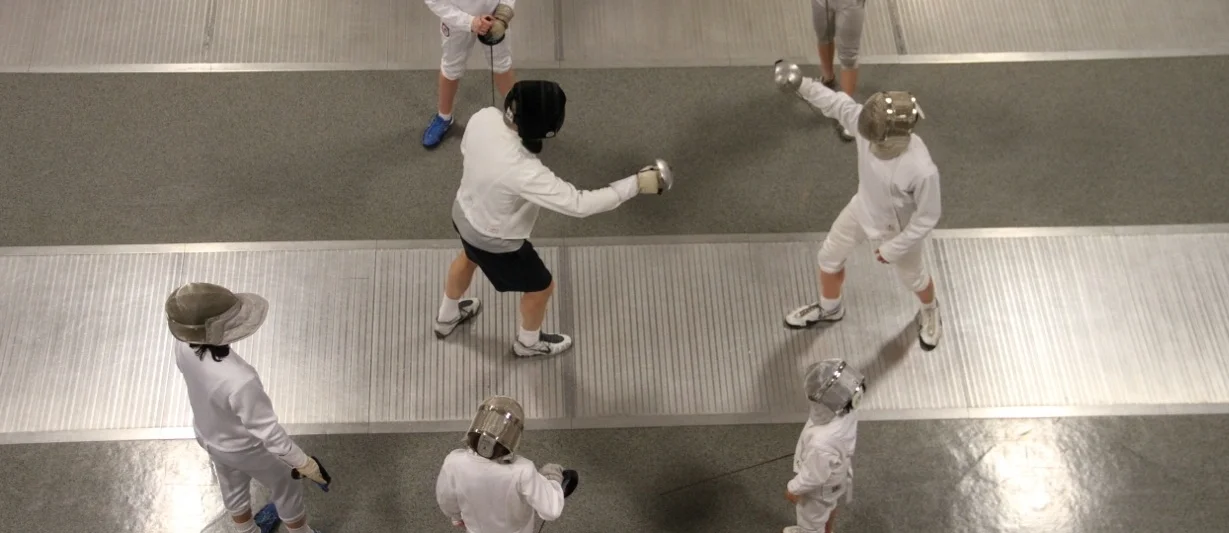My child wants to try fencing, but I don’t know how or where to start. What do you suggest?
Contact us at info@oregonfencing.com to arrange a visit to OFA, talk with us about an individual Learn to Fence package, or enroll in a week-long summer camp at a local school or recreation district. Our youngest fencers usually begin with our popular Saturday morning class. Our adult beginner class is on Tuesday evenings.
What is sabre, and why does OFA specialize in this one weapon?
Sabre is the fastest, most exciting of the three fencing disciplines, which include foil and epee. It’s a sport of movement, distance, timing and acceleration. OFA Head Coach Ed Korfanty helped develop modern sabre techniques, and our students have had great success over the years. It’s a crazy fun sport, and thrilling to watch. Our fellow sabre enthusiasts at Sydney Sabre produced a video that offers a glimpse of the speed and excitement of sabre, and explains some of the rules. Watch it here.
There are other Portland-area fencing clubs. Why choose OFA?
OFA is the only place that offers the opportunity to train with Head Coach Adam Skarbonkiewicz, an Olympic-level coach and former national champion fencer himself, and our talented assistant coaches. OFA fencers have won more Olympic and World Championships than any other club in the U.S. We really do build champions. And if your son or daughter dreams of fencing in college, our coaches have deep connections with many top college coaches.
It sounds like you’re an elite club. What if my child just wants to try fencing and become a recreational fencer?
OFA is a welcoming, friendly place for fencers of all ages and abilities. We always have several dozen young fencers just beginning to explore the sport, who come for the games and the laughter as much as for the fencing. We also have many teens and older fencers who started that way, fell in love with the sport, began to compete, and thanks to great coaching and their hard work, went on to fence in national and international competitions, and at prestigious Division 1 universities.
It’s hard to imagine watching my child in a swordfight. Is fencing safe?
Fencing is actually one of the safest sports. An analysis of injuries suffered by athletes competing in the 2008 Summer Olympics found that the sports with the fewest injuries were sailing, canoeing, rowing and fencing. Most blows in sabre fencing are nothing more than a tap, a touch, in fencing parlance. Some blows are harder, but in modern fencing the blade of the sword is not sharp. Additionally, each part of the body is covered with protective fencing clothing made from puncture-proof material. Masks protect the head and neck. By the way, it’s worth mentioning the sport that had the highest percentage of injuries in the 2008 Olympics: soccer.
Is my child too young, or too old, to start fencing? Am I too old?
There is no “best” or “only” age to start fencing. We have students as young as six, and some older than sixty, when they first come to OFA. USA Fencing competitions start with U10 levels, usually children that are 8, 9, and 10 years old. Many of our students first try fencing as a youth summer camp, but many others come to us as teenagers. Again, there is no right age to take up fencing.
I’ve heard that fencing is expensive. How much does it cost to get started?
Our individual Learn to Fence packages cost $150, and our entry group classes are affordable. We provide starter equipment so that you don’t have to purchase gear before your child decides that he or she wants to continue with the sport. There are many affordable local and regional fencing competitions. The higher costs come if your fencer decides to compete nationally and even internationally; as in other individual sports such as tennis, racquetball, and gymnastics, events are held all over the United States.
What qualities make a good fencer? Does my child need to be a really good athlete to be a good fencer?
Our fencers come in all shapes, sizes and fitness levels. Fencing is demanding both physically and mentally; it’s often described as “physical chess.” Unlike some other sports, it’s not about being the biggest and strongest. Yes, it can help to be agile and fast, but it is more important to be mentally quick and creative. These skills come through repetition and practice.

